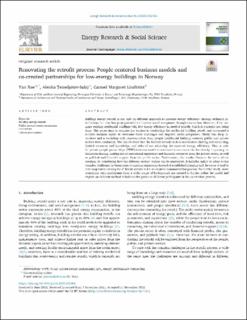| dc.contributor.author | Xue, Yan | |
| dc.contributor.author | Temeljotov Salaj, Alenka | |
| dc.contributor.author | Lindkvist, Carmel Margaret | |
| dc.date.accessioned | 2022-02-10T13:11:42Z | |
| dc.date.available | 2022-02-10T13:11:42Z | |
| dc.date.created | 2021-11-29T09:48:22Z | |
| dc.date.issued | 2022 | |
| dc.identifier.issn | 2214-6296 | |
| dc.identifier.uri | https://hdl.handle.net/11250/2978263 | |
| dc.description.abstract | Building energy retrofit is not only an efficient approach to increase energy efficiency through technical installations, but also has great potential to improve social acceptance through co-creation. However, there are many existing residential buildings with low energy efficiency in need of retrofit, which is currently not being done. This paper aims to examine the barriers to conducting the residential building retrofit and co-created a suitable business model to overcome these challenges and improve social acceptance. Thirty-nine deep interviews and a workshop with representatives from people (residential building owners), public and private sectors were conducted. The results show that the barriers include lack of information sharing and consulting, limited resources and knowledge, and risks of not achieving the expected energy efficiency. Then a public–private-people partnerships (PPPP) business model is co-created to overcome the barriers by improving information sharing, making use of operational experience and financial resources from the private sector, as well as political and financial support from the public sector. Furthermore, the results illustrate the value of co-creating, by considering how the different sectors’ wishes can be negotiated. It includes agility to adapt to the complex challenges by being open to ongoing suggestions instead of established planning and the scope to lead to new cooperation among the different sectors in the co-creation communication process. For further study, more workshops with participants from a wider range of backgrounds are needed to further refine the model and explore an efficient method to balance the power of different participants in the co-creation process. Keywords : PPPP; Public-private-people partnerships; EPC; energy performance contracting | en_US |
| dc.language.iso | eng | en_US |
| dc.publisher | Elsevier | en_US |
| dc.rights | Navngivelse 4.0 Internasjonal | * |
| dc.rights.uri | http://creativecommons.org/licenses/by/4.0/deed.no | * |
| dc.title | Renovating the retrofit process: People-centered business models and co-created partnerships for low-energy buildings in Norway | en_US |
| dc.type | Journal article | en_US |
| dc.type | Peer reviewed | en_US |
| dc.description.version | publishedVersion | en_US |
| dc.source.volume | 85 | en_US |
| dc.source.journal | Energy Research & Social Science | en_US |
| dc.source.issue | 102406 | en_US |
| dc.identifier.doi | https://doi.org/10.1016/j.erss.2021.102406 | |
| dc.identifier.cristin | 1960581 | |
| cristin.ispublished | true | |
| cristin.fulltext | original | |
| cristin.qualitycode | 1 | |

